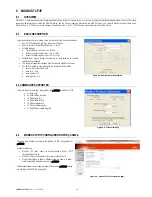
pCOWeb
+030220966 – rel. 1.1 – 12.12.2017
51
“root” USERNAME
Access with the “root” identifier is used internally to run critical applications for which the operating system requires special permission; logging in with this Username
means there are no restrictions; therefore, it is important to set a Password other than the default “froot” to prevent potentially dangerous outside access.
“httpadmin” USERNAME
This is the only Username of interest to the user of the
pCOWeb
and must be used to access the user memory via FTP or SCP.
This type of identification only allows functions relating to the memory, as established by CAREL. Setting a new Password for this User prevents unwanted
access to the memory.
“carel” AND “guest” USERNAMES
These are used internally to run applications. They have no interest for the user of the
pCOWeb
, except to change the default Password so as to increase security.
IMPORTANT: If the password is forgotten, the only way to access the operating system functions protected by the Username/Password is to start
pCOWeb
with the factory Passwords pressing the button, as described in 3.1.2 on page 12.
9.9
VARIOUS TESTS: PING -
pCO
VARIABLES - NOTIFICATIONS - E-MAIL
The “Tests” page features the following tests:
IMPORTANT: the Gateway normally needs to be set, see 9.4.1 on page 45.
Specify the name (a DNS must be set – see 9.4.1 on page 45) or the IP address, then select the “Ping” button; the command asks the recipient to respond to
acknowledge reception; after sending the command,
pCOWeb
will display the outcome on the confirmation page; see
Figure 9.v
, showing a successful ping
on the left and a failed ping on the right.
Figure 9.u – Test page
Figure 9.v - Results of the “Ping” command
•
Read/Write by pCOx: is used to read or write the contents of a
pCO
variable using the page shown in
Figure 9.w
sotto;
Choose the variable: choose the variable to be read or written;
IMPORTANT: The selection is also common to the write function and only becomes effective after selecting the “Read” button; the “Write”
button does not confirm the selection made in the “Choose the variable” section, but rather writes the values shown on line with the “Write”
button and highlighted in
Figure 9.w
;
Current value: value read; this may be numeric or “U” (for the meaning of “U” see 9.2.2 on page 42);
Variable <Type> <index> new value: enter the new value for the variable and select Write, then wait for the outcome page and check whether
the value has been accepted (= the
pCO
application can write the variable) or has remained unvaried (= the
pCO
application manages the
variable as read-only);
















































